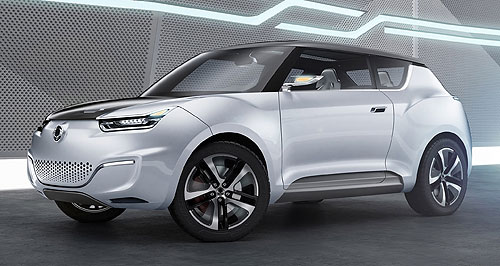Future models - SsangYong - e-XIVParis show: SsangYong electrifies its mini-SUV conceptSparked: SsangYong's stylish e-XIV concept combines a plug-in hybrid drivetrain with advanced compact SUV design study. SsangYong showcases latest plug-in range-extender powertrain in new XIV concept27 Sep 2012 By TERRY MARTIN SSANGYONG has taken the covers off its e-XIV concept in Paris this week, showcasing a plug-in hybrid powertrain within the latest instalment of its sub-compact SUV advanced design study. As illustrated in teaser images issued prior to the show, the e-XIV is based on SsangYong’s XIV-2 presented at Geneva in March, which itself was a modified version of the XIV-1 concept that captured the motoring world’s attention at the Frankfurt motor show in September last year. Still bearing a striking resemblance to the Range Rover Evoque, albeit in a downsized package, the XIV-2 has emerged with slight variations on the so-called ‘eXciting user Interface Vehicle’ theme, including the first application of the range-extender hybrid powertrain it announced at the 2011 Geneva show. In a similar vein to other plug-in hybrid vehicles, the e-XIV uses an electric motor as its primary power source, with a conventional internal combustion (IC) engine working in concert with a generator to extend the range far beyond the limits of a purely battery electric vehicle. In this case, the sleek SsangYong crossover relies on an 80kW permanent magnet synchronous motor, drawing from a 16kWh lithium-ion battery pack that offers a claimed full-electric driving range of up to 80km. The IC engine is a 1.0-litre two-cylinder petrol unit that supplies additional power via the generator to extend the driving range up to 600km, and emitting just 45g/km of CO2. In comparison, the Holden Volt – which uses a 1.4-litre four-cylinder petrol engine, two electric motors (for a combined 111kW) and a 16.5kWh battery – is capable of around 87km in full-electric mode, with that extending to a further 500km or more depending on the driving conditions. The Volt qualifies for a combined-cycle fuel economy rating of 1.2 litres per 100km, translating to CO2 emissions of 27g/km, although in range-extender mode it consumes around 4.2L/100km. SsangYong claims the normal charging time for its e-XIV via a conventional electricity supply is four hours, or as little as 20 minutes using a higher-voltage rapid-charge outlet. Few other technical details are available, although the specifications put the e-XIV’s top speed at 150km/h and a solar panel is also embedded into the glass roof to convert solar energy to electric power for auxiliary equipment such as the air-conditioning, audio system and cabin lights. The solar module is said to have a maximum power of 80 Watts, with a circuit of 20 cells at 4W each, while SsangYong says the functional design feature also serves to “maximise the emotional connection of driving in the open while enjoying the thought that ‘free’ solar power is being harvested”. It also has the practical benefits of providing plenty of natural light and enhanced spatial comfort and improved visibility in the cabin. Although this is the third iteration of the XIV advanced concept series, the e-version appears to be no closer to production than the previous iterations, and indeed the powertrain is more likely to be first used on the Korando compact SUV. The Korando has also been the subject of range-extender and pure-electric concepts in previous years, such as in the ‘KEV’ series. The e-XIV rests on the now-familiar 2600mm ‘XIV’ wheelbase and measures 4160mm long, 1790mm wide and 1575mm high. SsangYong has previously made it clear that the series is “more than just a design study” and instead a pointer to its “premium B-segment crossover utility vehicle project, which will lead to the addition of another mass-production model to the Korean company’s range”. The company says the e-XIV “pursues crossover design through the combination of the SUV styling of a sports coupe that is suitable both for active driving in the country and short-distance motoring around the city”. The four-seater cabin has flexible seating arrangements that allow for a variety of seating combinations and/or cargo load configurations. SsangYong says the interior evokes the “sporty style of a crossover” and blends a mix of styling cues and materials including carbon-fibre. A hi-tech multimedia interface for the driver is also included. As GoAuto has reported, the Australian distribution of SsangYong vehicles will change hands from Sime Darby to Ateco Automotive on November 1, under a new private company known as SsangYong Automotive Australia. The new outfit has ambitious plans to grow sales in Australia, and will be looking closely at all models and powertrains coming down the pipeline.  Read more17th of September 2012  New SsangYong importer plans sales, dealer expansionTime right for SsangYong to step up, says new importer Neville Crichton11th of September 2012  Paris show: SsangYong plugs inSsangYong teases e-XIV plug-in hybrid crossover vehicle ahead of Paris public debut7th of March 2012  Geneva show: SsangYong XIV-2 convertible crossoverConvertible XIV-2 SUV, petrol Korando among SsangYong’s Geneva show treats14th of February 2012  Geneva show: SsangYong's ‘convertible’ crossoverSsangYong to showcase open-topped XIV-2 crossover SUV concept at Geneva15th of September 2011  Frankfurt show: SsangYong shows micro-SUV pathBaby SsangYong SUV confirmed for production following XIV concept’s show debut |
Click to shareSsangYong modelsResearch SsangYong Motor industry news |


























Facebook Twitter Instagram